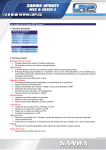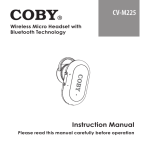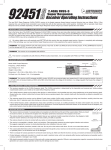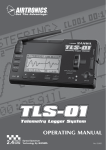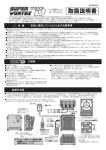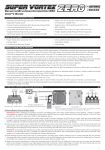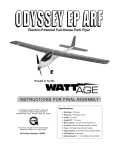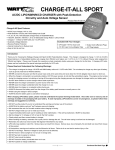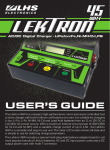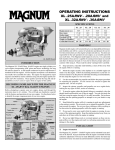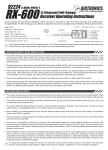Download AIRTRONICS M12 User`s guide
Transcript
RX-472 w/Sanwa Synchronized Link 2.4GHz FH4T Super Response Receiver User's Guide The RX-472 2.4GHz FH4T Super Response 4-channel receiver with Sanwa Synchronized Link (SSL) features an extremely low latency time and high frame rate, which makes you feel more connected to your model than ever. Combined with Airtronics or Sanwa Super Response SRG digital servos, the RX-472 will give you reaction speeds like never experienced before! This new receiver, when used with an Airtronics M12 or Sanwa EXZES-Z transmitter and the Sanwa Super Vortex ZERO ESC or other SSL compatible ESC, allows you to change many ESC programming mode options directly from the transmitter using the transmitter's CODE AUX function. This saves you the time and hassle of not needing to stop and make adjustments manually through the ESC. You can make these adjustments on the fly. In addition, telemetry data such as speed or RPM, ESC temperature, motor temperature (if supported), and battery voltage can be read directly from the Super Vortex ZERO ESC and displayed on the transmitter. IMPORTANT: This receiver is not compatible with Airtronics or Sanwa FH2 surface transmitters or aircraft transmitters. SSL function only available when used with an M12 or EXZES-Z transmitter and Super Vortex ZERO ESC or other SSL compatible ESC. Super Response (SSR) feature only available when used with an Airtronics or Sanwa FH4T transmitter in SSR Mode with Airtronics or Sanwa Super Response SRG digital servos. Telemetry requires telemetry capable transmitter (M12, EXZES-Z, MT-4) AND Super Vortex ZERO ESC or other SSL compatible ESC. If not using the Super Vortex ZERO ESC, the RX-472 can send telemetry data for the voltage of the receiver battery pack only. 2.4GHz frequency band precautions • This receiver operates on the 2.4GHz frequency band. The 2.4GHz connection is determined by the transmitter and receiver pair. Unlike ordinary crystal-based systems, your model can be used without frequency control. • Due to differences in the implementation of 2.4GHz technology among different manufacturers, this receiver is not compatible with any other transmitter brands. • The 2.4GHz frequency band may be used by other devices, or other devices in the immediate area may cause interference on the same frequency band. Always before use, conduct a bench test to ensure that the servos operate properly. Also, conduct checks with the transmitter as distant as possible from your model. • The response speed of the receiver can be affected if used where multiple 2.4GHz transmitters are being used, therefore, carefully check the area before use. Also, if response seems slow during use, stop your model immediately and discontinue use. • If the 2.4GHz frequency band is saturated (too many transmitters on at once), as a safety precaution, the transmitter and receiver may not bind. This ensures that your radio control system does not get hit by interference. Once the frequencies have been cleared, or the saturation level has dropped, your transmitter and receiver should be able to bind without any problems. Receiver precautions • If you're using analog servos, DO NOT use SHR or SSR Servo Modes for that channel, otherwise the servos and/or receiver can be damaged. • Do not plug any device other that an SSL compatible device or a switch harness w/receiver battery into the BATT/SSL port. • The antenna consists of a coaxial cable and a reception wire (the thin tip at the end of the coaxial cable). When you mount the antenna, do not bend the reception wire. Reception performance decreases if the reception wire is bent. The coaxial cable can be bent into gentle curves, however, do not bend the coaxial cable acutely, or repeatedly bend it, or the antenna core can be damaged. Antenna Reception Wire Coaxial Cable Antenna Tube • The antenna should be installed into a vertical plastic tube per your particular model's assembly instructions. See diagram. Keep the antenna as far away from the motor, battery and ESC as possible. The antenna should not come into contact with any carbon or metal chassis components. • The receiver is susceptible to vibration, shock and moisture. Take appropriate measures to protect against vibration and moisture. We suggest wrapping the receiver in shock-absorbing foam when installing it into your model. • The antenna is delicate, therefore, handle it with care. Do not pull on the antenna with force. Do not cut the coaxial cable or the antenna reception wire. Do not alter the length of either the coaxial cable or the antenna reception wire. • There is a danger of runaway operation if connectors loosen during use. Make sure that all connectors are securely fitted. Receiver specifications, led condition indicator and connections IMPORTANT: The receiver's Nominal Input Voltage is 3.7 to 7.4 volts. A 2 cell LiPo or LiFe battery pack can be used to power the receiver without the use of a voltage regulator. In addition, this allows you to take advantage of the higher torque and speed provided by using 7.4 volt servos. Only use a 2 cell LiPo or LiFe battery pack if your servos are rated to handle the higher voltage! • We suggest binding the transmitter and receiver and making all receiver connections to check for correct operation prior to mounting the receiver in your model. See the Binding the Transmitter and Receiver section on the reverse side. • After binding the transmitter and receiver, choose the desired Servo Mode and program the Fail Safe function. Bind LED Specifications: • Frequency: 2.4GHz FH3/FH4T Selectable Via Transmitter • Nominal Input Voltage: 3.7 to 7.4 Volts BATT/SSL* CH 4 - Auxiliary 2 CH 3 - Auxiliary 1 CH 2 - ESC CH 1 - Steering • Weight: 0.23oz (6.6g) • Dimensions: 1.18 x 0.91 x 0.55in (30.0 x 23.3 x 14.0mm) • Battery Fail Safe Limit: 3.5 to 5.0 Volts (FH3) / 3.5 to 7.4 Volts (FH4T) Coaxial Cable Bind LED Condition Indicator: = Signal = Positive = Negative The Bind LED on the receiver can be used to determine receiver condition at a glance. The Bind LED will alert you to various receiver conditions, as described below: Condition LED Blue Receiving RF Signal Blue Flash Slow/Blue Flash Fast Binding Operation Red & Blue Flashing Receiver Battery Fail Safe Activates Red No RF Signal After Receiver Battery Fail Safe Activates Bind Button Antenna Reception Wire *If using the Sanwa Super Vortex ZERO or other SSL compatible ESC, plug the ESC into the BATT/SSL slot, otherwise SSL features and telemetry data will not be available. All other ESC's should be plugged into the CH 2 - ESC slot. binding the transmitter and receiver The binding procedure allows you to bind the transmitter and receiver pair. Once the binding procedure is complete, the setting is remembered even when the transmitter and receiver are turned OFF. The bind code is unique to each transmitter and receiver pair, so you don't need to worry about other users' transmitters interfering with your receiver. IMPORTANT: Before beginning the binding procedure, make all receiver connections as described on the reverse side. If there is a problem binding the transmitter and receiver with the ESC connected, disconnect the ESC and use a separate battery pack to power the receiver. After completing the binding procedure, disconnect the battery pack and reconnect your ESC. 1) Turn the transmitter ON and navigate to the BIND menu, then choose your transmitter's modulation type. If using an M12, EXZES-Z, MT-4 or other FH4T transmitter, choose FH4T. If using an M11X, MX-3X or other FH3 transmitter, choose FH3. 2) While holding down the Bind Button on the receiver, turn the receiver ON. The Bind LED on the receiver will flash slowly. After approximately 2 seconds, release the Bind Button. The Bind LED on the receiver will continue to flash slowly. 3) From within the transmitter's BIND menu, press the ENTER key on your transmitter. The [ENTER] command will begin to flash and the Bind LED on the receiver will flash rapidly, then go out. 4) After the Bind LED on the receiver goes out, press the ENTER key a second time. The Bind LED on the receiver will illuminate solid blue, indicating that the binding procedure is complete. 5) Move the steering wheel and throttle trigger to verify that the servos are operating normally, then press and HOLD the Back/Cancel key to exit the BIND menu. IMPORTANT: The BIND menu may vary depending on your transmitter model. If necessary, refer to your transmitter's User's Guide for more information about binding the transmitter and receiver. When the binding procedure is successful, the Bind LED on the receiver will illuminate solid blue. If the Bind LED on the receiver is flashing rapidly or is not illuminated at all, the transmitter and receiver are not paired. In this case, turn both the transmitter and receiver OFF, then repeat the binding procedure again. servo mode setting The Servo Mode setting is used to change the response time of the receiver to suit the type of servos you're using. The combination of using digital servos and using the correct Servo Mode setting results in increased reaction speed and improved feel, making you feel more connected to your model than ever. For example, using the SHR Servo Mode setting with any brand of digital servo will increase the servo's response time, even above the manufacturer's specification. For the fastest response time possible, use the SSR Servo Mode setting with Airtronics or Sanwa Super Response SRG digital servos. For more information about the Servo Mode setting and how to program it, refer to your transmitter's User's Guide. The following Servo Modes can be programmed from your transmitter's Modulation Menu: NOR - Use with any brand of Analog or Digital servos and ESCs. SHR - Use with any brand of Digital servos only. Do not use with Analog servos! SSR - Use with Airtronics or Sanwa SRG Digital servos only. Do not use with Analog servos or any other type or brand of Digital servos! WARNING: If you're using analog servos, DO NOT use SHR or SSR Servo Modes for that channel. Use the NOR Servo Mode with analog servos. Using SHR or SSR Servo Modes with analog servos can result in damage to the servos or the receiver! Not all ESCs are compatible with SHR or SSR Servo Modes. If your ESC does not operate correctly with SHR or SSR Servo Modes, change the Throttle Channel Servo Mode to NOR. The SSR Servo Mode is available only when using FH4T modulation. In addition, Servo Mode options may differ depending on the transmitter model used. When switching between SHR and SSR Servo Modes, your model's End Point Adjustment (EPA) settings may be altered. In this case, you should double-check the EPA settings and readjust them if necessary. fail safe function The Fail Safe function can automatically move the servos to a predetermined position in the event that the signal between the transmitter and the receiver is interrupted, whether due to signal degradation or low transmitter battery. The Fail Safe function can be programmed independently on all four channels and three options are available: FREE, HOLD and PERCENTAGE. For information about programming the Fail Safe function, refer to your transmitter's User's Guide. IMPORTANT: The Fail Safe function will NOT OPERATE if the receiver loses power. It will operate only if the transmitter and receiver signal is interrupted or if the transmitter loses power. A Receiver Battery Voltage Fail Safe function is also featured, however, it is used with glow- or gaspowered models. It's not necessary to program this feature when used with an ESC. warranty and service information Your Airtronics RX-472 receiver is warranted against manufacturer defects in materials and workmanship, at the original date of purchase. This warranty does not cover suitability for specific application, components worn by use or improper voltage, tampering, modification, misuse, abuse, improper wiring, reverse polarity, moisture damage or acts of God. Any modifications or abuse of the product will void the warranty. Crash damage will not be covered by the warranty. The receiver is not waterproof. Water damage will not be covered by the warranty. Damage to the receiver or your servos caused by using analog servos in SHR or SSR Servo Modes will not be covered by the warranty. For additional warranty and service information, please visit http://www.airtronics.net/index.php/service. For Service and Support in North America Only: Global Services/Airtronics Customer Care 18480 Bandilier Circle Fountain Valley, CA 92708 Telephone: (714) 963-0329 Fax: (714) 964-6236 Email: [email protected] This device complies with Part 15 of the FCC Rules and with RSS-210 of Industry Canada. Operation is subject to the following two conditions: 1) This device may not cause harmful interference, and.... 2) This device must accept any interference received, including interference that may cause undesired operation. Changes or modifications made to this equipment not expressly approved by Airtronics may void the FCC authorization to operate this equipment. Features and Specifications are Subject to Change Without Notice. All contents © 2013 Airtronics, Inc. All Rights Reserved. Revision 1 07.18.2013 (P/N 92015)


